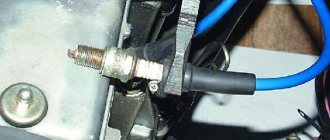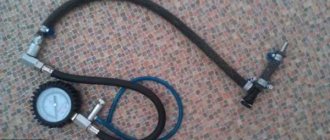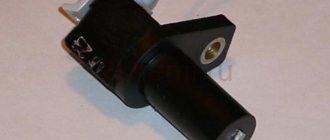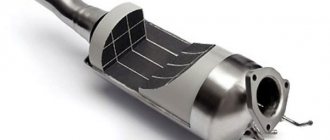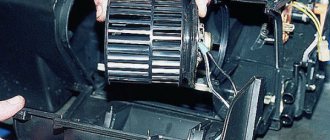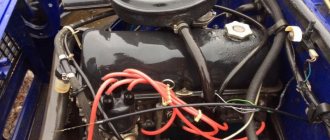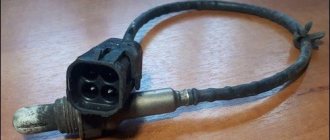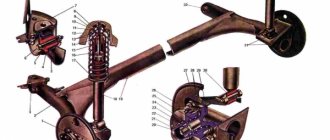In our short article we will talk about the VAZ-2110 fuel system (injector). Carburetor engines have long gone into oblivion. The manufacturer has not installed such motors since the early 2000s. Most of the “ten” and similar models (2112, 2111) are equipped with engines with a fuel injection system. It is more reliable, works stably, and most importantly, does not require frequent intervention from the driver. The engine will be able to operate without problems, but provided, of course, that all filters are changed in a timely manner. There is also a requirement for fuel - it is not recommended to use low-quality fuel.
Details on how to independently measure fuel pressure on a VAZ 2110
Fuel pressure in the power supply system of a VAZ vehicle plays an important role in the operation of the power unit under various loads. What should be the pressure in the fuel rail and the reasons for its violation in the fuel system of a VAZ 2110 car, as well as how to solve this problem, you will learn from this publication.
If the VAZ 2110 engine starts to stall at idle, and when driving uphill there is a loss of power, most likely the fuel pressure in the system is not normal. In such cases, it is necessary to carry out diagnostics and identify the causes of the malfunction. To check the fuel pressure, you will need a special device with a pressure gauge, which is connected to the fuel line and the corresponding measurements are taken at different engine operating modes. An alternative to such a device can be the most common pressure gauge for checking the pressure in car tires with a rubber hose with an internal diameter of 9 mm connected to it.
How to check the pressure in the fuel rail of a VAZ 2110
- There is a fitting on the fuel rail of the VAZ 2110 engine, which is closed with a plastic cap. It is to this fitting that we will connect the pressure gauge to measure the fuel pressure. After removing the cap, unscrew the nipple and put on the hose, securing it with a metal clamp. Details on how to independently measure the fuel pressure on a VAZ 2110. Be careful if there is excess pressure; when unscrewing the nipple, a certain amount of gasoline may spill out. To prevent this from happening, you can relieve the pressure in the VAZ 2110 fuel system in advance by removing the fuel pump fuse, start the engine and let it stall on its own, then return the fuse to its place.
- After the pressure gauge has been connected, you can start the engine and check the readings at idle and with the vacuum hose removed.
Allowable fuel pressure values for VAZ 2110
- Idle speed - 2.8–3.2 bar (2.8–3.2 atm)
- With the vacuum hose removed, the VAZ 2110 fuel pressure may rise by 0.2–0.7 bar (0.2–0.7 atm), which indicates that the pressure regulator is working properly.
Find out more about self-repair of VAZ cars
Fuel pressure control
The fuel pressure regulator (aka FPR) is designed to maintain constant pressure in the fuel injector. On one side, a spring with a special valve exerts pressure on it, and on the other, gasoline. The bottom line is that it maintains the same pressure under different engine operating conditions, and when the load is removed, it sends an excess amount of gasoline back to the tank, thereby saving fuel and maintaining pressure in the fuel supply system.
The most common fuel regulator malfunctions
- The pressure is gone . This is why gasoline is pumped back into the gas tank and the car does not start.
- The valve becomes clogged and gasoline is difficult to flow through. As a result, gasoline begins to leak from almost everywhere. This is the most important malfunction of the pressure regulator. As soon as gasoline consumption increases sharply, you can immediately change the regulator.
- This reason is a development of the second. The valve becomes completely clogged and gasoline does not enter the fuel supply system.
- Uneven pressure . Usually caused by a stuck valve. Because of this, the car moves unevenly: it jerks or even stalls.
However, not all faults point to the valve, therefore, it is necessary, first of all, to learn how to check the pressure regulator, and then draw the appropriate conclusions.
Causes of RDP malfunctions
Most often, the valve fails due to sagging of the spring, which begins to wedge. This is caused by natural wear and tear of the metal and, unfortunately, there is no escape from it. This can also be caused by the car being idle for a long time. To prevent this from happening, the car needs to be driven more often.
The second reason why the regulator fails is low-quality fuel. Many gas stations dilute fuel with water to increase volume and make more money. Therefore, refuel only at trusted gas stations.
How to check the fuel pressure regulator of a VAZ 2110
When the first cars equipped with carburetors appeared on the VAZ assembly line, the pressure in the system was measured using the jet density created by disconnecting the valve or pinching it. However, after the market began to fill with injection cars, this method became very outdated.
Currently, pressure is measured using a pressure gauge, which is connected between the hose and the fitting. The vacuum hose must be removed. The measurement is made at idle and the measurement result is individual for each pressure regulator. Typically, the pressure rating can be found on the body of the product.
During the measurement process, after disconnecting the vacuum hose, the pressure should increase by 0.5 bar and if this does not happen, then the vacuum hose must be replaced.
How to check fuel pressure in the rail - step-by-step instructions
The main indicator of a malfunction of the engine power system in VAZ 2110, 2111 and 2112 vehicles is the fuel pressure in the fuel rail.
So, if the fuel pressure is insufficient, the following symptoms occur:
- the engine stops at idle;
- unstable engine operation;
- reduced or increased crankshaft speed at idle;
- poor car response;
- dips or jerks in engine operation while it is moving.
The first thing to do in this case is the reliability of the electrical contacts of the injection system, which are responsible for supplying fuel to the system (injectors, fuel pump).
The fuel pressure in the rail can be checked using a pressure gauge with a hose and an adapter for connecting to the rail. So, let's move directly to the process of checking the pressure:
- The first thing to do is turn on the ignition and wait a few seconds for the fuel pump to start working. If you do not hear the sound of the fuel pump, then you should check the electrical power circuit of the pump.
Note: if you turned on the ignition 3 times in a row and did not turn on the starter, then once again the fuel pump may not work - this is quite normal and is not a malfunction; it will start working simultaneously with the engine starting.
- Next, reduce the pressure in the power system. In order to check the fuel pressure in the rail, you must connect a pressure gauge with a measurement limit of at least 5 kgf/cm2.
- We start the engine and check the pressure.
Normal idle pressure should be about 300 kPa (3.0 kgf/cm2) for engines 2111 and 2112 and about 380 kPa (3.8 kgf/cm2) for engines 21114 and 21124.
Low fuel pressure can be due to several reasons:
- fuel pump malfunction;
- Fuel pressure regulator malfunction.
- We turn off the engine and reduce the pressure in the power system.
- Disconnect the pressure gauge from the ramp control valve and screw on the valve cap.
Fuel pressure regulators Lada
Automotive service technicians and home-grown car enthusiasts are familiar with countless elements of vehicle measurement, thanks to a measurement system invented and implemented by French engineers in 1790 called the metric system.
Creating and repairing a car requires mastery of all measurement techniques. It is necessary to understand and distinguish between concepts such as volume, length, time, interval and much more. In cars, tolerances are measured in thousandths; today, in many cases this is not enough and must be measured in tens of thousandths for optimal and efficient operation of all components and mechanisms.
The tools that are most needed today in measuring any element are:
- high-quality set of micrometers;
- set of pressure gauges;
- spring testers;
- surface roughness testers;
- vacuum testers;
- and this is just the beginning.
The car's fuel system itself can be divided into three main elements: power, pressure and return. The high pressure pump is the starting point of the system. Pumps may differ in design, but the basic principle is the same. Next come the fuel lines from the fuel tank and the filter. The fuel is kept under pressure in the system by a pump. The fuel line is connected to the fuel rail with high pressure steel lines emanating from it to power the individual injectors.
Having a fuel pressure regulator helps reduce fuel temperature, reduces pump load, reduces parasitic load on the engine, reducing emissions.
No pressure in the fuel rail VAZ 2110 8 valves
pressure in the VAZ ramp is free. check, pressure, ramp, VAZ, check.
2.1.10 VAZ 2115 timing belt.
Fuel rail - checking operating pressure.
How to remove the fuel rail on a VAZ-2111 car engine yourself.
2. Remove the decorative trim of the engine (see 8.1.4).
Comment on Removing and replacing the fuel rail of the VAZ-2111 engine.
Removing the fuel rail of the VAZ-2112-8 engine.
If the regulator is working properly, the fuel pressure should increase by 0.2–0.7 bar (20.
We move the pressure plate of the fuel supply pipe along the ramp and remove the pipes.
There is no pressure in the fuel rail of the VAZ 2110.
The tuning pressure is 6 atm in the VAZ fuel rail, not in order.
Removal and installation of the fuel rail and regulator VAZ fuel 2110, VAZ 2111.
Removing the fuel rail and fuel pressure regulator of the VAZ-2112 engine.
2.17.1.7. Checking and replacing the fuel pressure regulator.
Removing the fuel rail of the VAZ-2111-1 engine.
a special membrane-type valve, on which it turns on one side.
Pressure in the fuel rail of a VAZ 2110 - pictures and photos.
Checking the pressure in the fuel rail of a VAZ 2109 Do it yourself.
It is installed in the injector rail and represents.
8. Screw in the bleeder fitting until it stops.
DIY car repair. fuel rail. DIY car repair.
diagram for disassembling the fuel rail of a VAZ 2110.
There is no pressure in the fuel rail of the VAZ 2110.
If the regulator is working properly, the fuel pressure should increase by 0.2–0.7 bar (0.
There is no pressure in the fuel rail of the VAZ 2110.
Fuel Rail - Operating Pressure Check
The operation is shown on engine 21114. Checking the fuel pressure on other engines is performed in the same way.
Before performing the operation, read the safety rules when servicing and repairing the power system (see “Safety precautions when servicing and repairing the power system”).
To perform the work you will need a special pressure gauge.
1. We prepare the car for work (see “Preparing the car for maintenance and repair”).
2. On engines models 2112, 21114 and 21124
remove the decorative trim (see “Decorative engine trim - removal and installation”).
3. Unscrew the protective cap of the fuel rail diagnostic fitting.
4. Connect the tip of the pressure gauge hose to the fuel rail fitting.
5. 14 mm
wrap the end of the hose.
If necessary, the pressure in the fuel rail can be measured with a homemade device, made from a pressure gauge from a foot pump. Before connecting such a pressure gauge, the fuel pressure must be relieved (see “Fuel Line - Pressure Relief”). After this, unscrew the spool from the fuel rail fitting. This can be done with a metal wheel valve cap. To connect the pressure gauge to the fuel rail fitting, use a piece of gas-resistant hose of suitable diameter. The ends of the hoses must be securely secured with clamps.
6. Turn on the ignition. The fuel pump will run for a few seconds. After waiting until the pump stops working, turn off the ignition.
7. To remove air from the pressure gauge, lower the end of the drain tube into a small container, unscrew the bleeder fitting of the pressure gauge 1/3-1/2 turn and release excess gasoline pressure from the fuel rail. This will remove air from the pressure gauge hose.
8. Screw in the bleeder fitting until it stops.
We start the engine and measure the operating pressure in the fuel rail at different crankshaft speeds. For a working engine it should be within the following limits: for engines 2111 and 2112
— 284-325 kPa (2.8-3.2 bar);
for engines 21114 and 21124
- 378-390 kPa (3.8-3.9 bar).
On 16-valve engines, the operation is as follows:
On engines 2111 and 2112, disconnect the rubber hose from the pressure regulator pipe. If after this the fuel pressure does not increase by more than 0.2 bar, then the regulator is faulty.
9. Turn off the ignition.
10. Having lowered the end of the tube into the container, open the fitting and relieve pressure from the fuel line.
11. Disconnect the pressure gauge from the diagnostic fitting of the fuel rail.
12. Screw the protective cap onto the fuel rail fitting.
Recommendation.
If the operating pressure in the fuel rail is unstable or higher than normal, then the fuel pressure regulator is faulty (see “Fuel module of engines 21114 and 21124 (1.6i) - replacing the fuel pressure regulator", “Fuel rail of engine 2111 (1.5i 8V) - replacing the fuel pressure regulator”, or “Fuel rail of engine 2112 (1.5i 16V) - removal, disassembly, assembly and installation”). Low pressure (less than normal) can also be caused by a malfunctioning regulator. The fuel pump strainer may be clogged or the fuel pump may not be producing the required pressure. To clean the strainer, you need to remove the fuel module (see "2111 and 2112 (1.5i) Engines Fuel Module - Removal and Installation", or "21114 and 21124 (1.6i) Engines Fuel Module - Removal and Installation".
Checking the pressure in the fuel rail on VAZ and Lada cars with an injection engine
The article will describe a testing technique that does not require special devices.
From the tool you will need:
1. We took a regular gas pressure gauge with a scale of up to 1.0 MPa. It has a threaded connection and screws perfectly onto a 9 mm oxygen hose. You can use a mechanical one to check tire pressure. They are usually inserted into the fuel hoses by 8 mm.
2. Screw it into the hose and tighten it with a clamp:
3. Unscrew the plastic cap from the fuel rail. It should unscrew by hand, but if it hasn’t been touched for a long time, you may need pliers:
4. If the car has just been turned off, then the gas in the ramp is under pressure. First, it is recommended to release the pressure by pressing on the spool and placing a rag or a plastic “bottle” with the neck cut off. It is more convenient to bleed using a wheel cap.
5. Unscrew the nipple with the cap. It is similar to a wheel nipple:
6. We put a hose with a pressure gauge on the threaded part and tighten the connection with a clamp:
7. Start the car and first of all make sure that there are no gasoline leaks from the connections. Then we look at the pressure gauge readings.
8. For fuel systems with “return” (a pressure regulator is installed on the fuel rail, from which a tube goes back to the tank), a pressure of 2.7 atm is considered normal (when re-gasping it should jump up to 3 atmospheres). However, a pressure of 2.5 atm is also acceptable. If the pressure is less, then the fuel system is faulty. Pressure pulsation (0.2 atm) indicates a clogged coarse mesh (located in the tank with the fuel pump).
Idle speed adjustment
On carburetor engines, cold starting was quite difficult - it was necessary to pull the “choke” cable so that more gasoline and less air entered the combustion chambers. And it was necessary to open the air supply in a timely manner, otherwise the car would “eat” gasoline very greedily. As for adjusting the idle speed on injection engines, a specially designed engine (IAC) is used for this.
When the valve is closed, air enters the fuel rail through a thin channel, bypassing it. This channel is closed by a conical needle, which is mounted on the regulator. The microcontroller control system, depending on the engine operating mode, sends a signal to the electric motor. At the same time, the needle moves, changing the air supply to the ramp. At the same time, a certain engine speed is maintained - specifically, 750 rpm.
Lada Priora Hatchback ✤ℨℰȴеℋÅЯ МОШℵИЯ!!! › Logbook › The main thing about the pressure in the fuel system.
Fuel pressure in the car system is one of the important parameters that is used in engine diagnostics. The behavior of the car in various operating modes depends on the pressure. How to measure the pressure in the fuel system with your own hands
For example, buy a device to check fuel pressure. A kit with a fuel pressure gauge, adapter and drain will cost you 1400-1500 rubles. Pay 300-400 rubles to the service station and take measurements there. You can also measure the pressure in the fuel system with an air pressure gauge, which is used to measure tire pressure. Here at this point in more detail. Let's take the example of the tenth VAZ 2110 family. Otherwise, the procedure is similar to any other car. The peculiarity of pressure gauges is that their initial scale values have relative inaccuracy. What does it mean. If the air pressure gauge has a scale of up to 16-20 atm (when the measurement limit for fuel is 5-7 atm), then pressure measurements will not be accurate due to this error, which will fall within the initial values of the instrument scale. Therefore, it is correct to check the fuel pressure with a fuel pressure gauge with a limit of 6-7 atm.
We take a pressure gauge and wrap a piece of foam (plumbing flax) under the pipe and put on an oxygen hose with an internal diameter of 9 mm. Secure with clamps. Place a rag on the generator (so as not to start a fire under the hood). Unscrew the plastic cap on the fuel rail.
put the hose on the pressure gauge
Under the cap there is a hole with a nipple. Unscrew it from the wheel cap. Due to the residual pressure in the rail after removing the nipple, gasoline will splash out.
If desired, you can relieve the pressure in the vehicle's fuel system. To do this, you need to remove the fuel pump fuse and wait until the running car stalls.
We put the second end of the hose on the ramp hole and secure it with a clamp. We remove the rag from the generator and start the engine. Don’t forget to cover the generator with a rag again before removing the hose from the ramp. That's it, now you know how to check the pressure in the fuel system in the field.
attach the hose with pressure gauge to the fitting
check the fuel pressure in the system
By the way, instead of clamps, you can use the classic adjusting bolt bushing. It screws perfectly onto the ramp fitting. To seal, we put a suitable rubber ring on the fitting. On the other side of the bushing we solder a fitting onto which we put a hose with a pressure gauge.
What pressure should be in the VAZ 2110 fuel system? 2.8–3.2 bar (2.8–3.2 atm)
How to measure fuel pressure in a system where there is no return? On VAZ 2110 with 1.6 liter engines, the pressure in the ramp is constant and amounts to 3.6-4.0 atm. Otherwise, the measurement technique is similar. Alternative ways:
It is measured at the outlet fitting of the fuel pump module - this is the one with one tube. You will need a flexible gas-resistant hose with an internal diameter of about 8 mm and a pressure gauge (you need to remove the tube and put on a hose with a pressure gauge instead). The pressure should be 5-7 atm. Close the return line, as is done on an internal combustion engine with a drain ramp, but you must turn it off again at the fuel pump itself. We pull off the second hose (double) and insert a plug into the removed hose, made, for example, from an old fuel filter (saw off the nipple from it and plug it). A single hose must be put on the pump fitting, and now the measurement must be made at the fuel rail. According to the power system diagram, everything will be clear.
Throttle design features
The throttle assembly is attached directly to the receiver. With its help, air is dosed, which enters the intake pipe. A throttle assembly is installed between the inlet pipe (with filter) and the ramp. The damper is connected to the gas pedal via a cable. A sensor is installed on the damper itself; it allows the electronic control unit to determine the position of the damper when the engine is running.
It is worth noting that the fuel system of the VAZ-2110 (16 valves) is approximately the same in design as that of an eight-valve engine. In the flow part of the throttle assembly (immediately before the valve and immediately after it) there are holes that allow vacuum to be removed. With their help, the system responsible for ventilation of the adsorber and crankcase operates. If an adsorber is not installed on the car, the fitting required for purging is closed with a rubber plug. On VAZ-21114 and VAZ-211124 engines there is no channel through which air is supplied to bypass the damper. The connecting flange also has a slightly different shape.
Pressure regulators VAZ 2110 - design and operation
A fuel pressure regulator (FPR) is needed to maintain gasoline pressure in the fuel system at a constant certain level, regardless of engine operation. It is installed in the injector rail and is a diaphragm valve connected to the fuel supply channel to the injectors, the drain line and the air tube supplied from the intake manifold.
The RTD valve is affected by fuel pressure, on the one hand, and, on the other, by air pressure in the tube and spring force, adjusted to certain operating parameters in the system. When the engine is running, a serviceable RTD maintains the following indicators in the system: 2.9–3.3 kgf/cm 2 (284–325 kPa).
Design Features
The fuel system design includes the following components:
- The fuel supply system itself consists of a gas tank, a pump, a pressure regulator, gasoline filters, a ramp and injectors, as well as connecting tubes and hoses. In other words, these are the elements in which gasoline is found.
- The air supply system is those elements that allow oxygen to pass through. This is an air purification filter, a pipe, a throttle assembly, and a flow sensor. It is with the help of these elements that purified air is supplied to the fuel rail to form a mixture.
- And the last system allows you to catch gasoline vapors. This is an adsorber and connecting tubes. With their help, couples are destroyed.
The fuel supply system is needed to ensure the presence of the required amount of mixture in the ramp when operating in any mode.
Types and symptoms of regulator malfunction
The types of RTD malfunctions are as follows. The valve does not hold - fuel begins to circulate freely throughout the fuel system, the pressure in which decreases because of this. As a result, the engine does not have enough fuel when the speed increases, and its power decreases; The pressure in the system should not change after stopping the engine, but since the valve is not able to hold it, when starting the engine, you have to work with the starter for a long time to create the required pressure.
A completely inoperative valve means fuel is not discharged into the tank, and because of this, the pressure in the system increases. As a result, the amount of fuel supplied to the combustion chambers through the injectors increases - there is overconsumption and incomplete combustion of gasoline.
Signs of a faulty RTD are the following engine operation:
- unstable;
- stalls at idle;
- insufficient pickup;
- cannot develop full power;
- the crankshaft rotates at idle speed with a reduced or increased frequency;
- dips and jerks while the machine is moving;
- difficult starting - not always;
- the content of CO and CH in the exhaust gases significantly exceeds the permissible standards;
- excessive consumption of gasoline.
Basic moments
The fuel system of the VAZ-2110 (8 valves or 16) includes a fairly large number of elements that affect the operation of the engine. It is also worth mentioning that a mixture of gasoline and air is supplied to the combustion chambers of any engine in a certain proportion (more precisely, 14 parts of air and 1 gasoline).
If this ratio is violated, the engine will start to work incorrectly - the speed will decrease or increase, and interruptions will appear.
How to check the pressure in a system with no return?
The VAZ-2110 with a volume of 1.6 liters has constant pressure indicators in the ramp, which, as a rule, vary around 3.6-4 bars.
In addition to the most commonly used measurement methods described above, there are several more unusual solutions:
a) Here we return again to the hose with a pressure gauge, the diameter of which should be 7.5-8 millimeters. Measurements should be taken at the outlet of the fuel pump module. Five to seven atmospheres are normal test results.
b) Remember how the return line is closed on motors with a drain frame. It is recommended to turn off the engine directly at the gasoline pump. Next, you will need to remove the double hose and insert a plug (“The nipple” from an old fuel filter may also be suitable for this task). Now you need to pull a single tube onto the pump fitting. The measurements themselves must be made at the fuel rail.
How to clear a blockage if the fuel supply line is clogged.
One of the reasons for low pressure may be a malfunction of the sensor that regulates the fuel pressure before injection. Low pressure may also be a consequence of a clogged fuel line. By taking proper measurements, you can accurately determine the cause of the malfunction. First, you should check the pressure of the pump and line, then measure the pressure in the ramp. All of the above will help determine the exact cause.
How to clear clogged fuel injectors.
There are several signs to tell you that your fuel injectors are dirty. Let's start in order.
- Difficulty starting the engine.
- Unstable engine operation.
- Dips in the timing of sharp pressure on the gas pedal.
- Loss of power and deterioration in acceleration dynamics.
- Increased toxicity of treated gases.
- Increased fuel consumption.
- The occurrence of detonation.
- Popping sounds in the exhaust system.
- Misfires.
To solve this problem you need to clean the fuel injectors.
Clogged valve. How to identify and fix the problem.
When the valve is clogged, fuel is difficult to pass through, and because of this, it begins to leak everywhere. A significantly increased fuel consumption indicates that it is time to change the regulator, since it is the leading component. Fuel stops being supplied to the supply system if the valve becomes completely clogged.
What to do if the valve is stuck.
Uneven pressure in the system is usually the result of a stuck valve. Because of this, the vehicle's movement may be uneven. The car may also jerk or stall.
Gasoline pump and purification
Using a two-stage electric drive, the fuel pump pumps gasoline into the line. The pump is of a rotary type, it is not dismountable, and is installed directly in the gas tank. This reduces the possibility of a vapor lock occurring, since gasoline is injected under high pressure and not under vacuum. The pressure value is about 284 kPa on VAZ-2111 and VAZ-2112 engines, and also over 364 kPa on VAZ-21114 and VAZ-21124 engine models.
The gasoline filter is built into the supply line directly between the ramp and the electric pump. It is located under the body, directly next to the fuel tank. The filter is a non-separable element; the housing is made of steel. Inside there is a paper type filter element. For rough cleaning of fuel, a so-called diaper is used, which is installed in the lower part of the pump.
